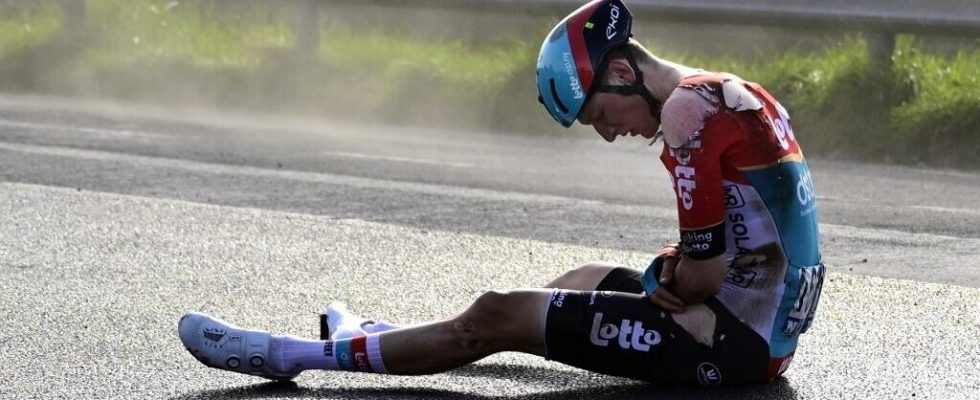Cycling, which is going faster and faster, proves week after week that this sport is dangerous. Over the last four days, three races have been marked by failures that were as spectacular as they were painful.
3 mins
Fallen during Across Flanders on Wednesday March 27, Belgian Wout van Aert suffered a broken collarbone and several broken ribs. Wout van Aert will miss the upcoming classics: the Tour of Flanders, Paris-Roubaix and the Amstel Gold Race, the first major objectives of his season. He is expected to be absent for many weeks after having surgery during the night from Wednesday to Thursday in Herentals, his hometown. Just after him, another Belgian runner, Jasper Stuyven, winner of Milan-San Remo in 2021, took to the pool in the same hospital to repair a broken collarbone. Luxembourger Alex Kirsch broke his hand.
Since the start of the season, dozens of runners have ended up in the ambulance
In France, part of the peloton found itself on the ground on Sunday March 24 during the Roue Tourangelle. Rebelote on Wednesday where a new massive fall at Paris-Camembert led to several abandonments, including that of Jason Tesson, winner of… the Roue Tourangelle.
Since the start of the season, dozens of runners have ended up in the ambulance. Just last month, several of them (Sénéchal, Rui Costa, Johannessen, Lemmen, Capiot, Ackermann, Kelderman, Gee…) broke their collarbones, the most common fracture among cyclists. Unfortunately, sometimes accidents take an even more dramatic turn, such as the death of Gino Mader while descending a pass during the Tour de Suisse last June.
On Across Flanders, the fall took place on an ultra-fast and reputedly dangerous false-flat descent, to the point that it was removed from the Tour of Flanders route. “ Maybe we’ll remove it on all our races », indicated Tomas Van Den Spiegel on behalf of the organizers of the “Flanders Classics”.
But the riders also have their share of responsibility by going faster and faster and braking later and later, also thanks to more efficient disc brakes. “ The average level of the peloton is very high and the pressure is enormous to be well placed at the front », underlines Belgian veteran Tim Declercq of the Lidl-Trek team.
Physical but also psychological damage
Now, during road cycling races, street furniture intended to slow down car traffic adds to the danger. “ By car we enter city centers at 30 km/h and we arrive at 60 km/h on a bike. Just saying that settles it », Estimates Frenchman Benoît Cosnefroy. “ Falls are part of our sport but we can act to protect runners », says Jan Bakelants, former wearer of the yellow jersey in the Tour de France, now a consultant for the Flemish media Sporza. This close friend of Wout Van Aert suggests “ a sort of airbag to put on your back like when skiing “. “ We need measures that mitigate the consequences of a fall “, he insists.
In the meantime, the runners deal with this game of massacres and the physical but also psychological damage it causes. A runner like the Frenchman Pierre Latour cannot overcome his fear of falling on descents, during which he is systematically let go. The Spaniard Enric Mas suffered from the same paralysis before overcoming the disease over time. Julian Alaphilippe, who came close to the worst by crashing into a tree on Liège-Bastogne-Liège in 2022, admits to having “ a little more afraid than before when things go quickly and we are not far from the fall “.
“ When you hear a big fall not far from you, the sound of carbon farting, guys yelling… we’re all scared. A cyclist who is not afraid, I don’t know any », confides Benoît Cosnefroy.
